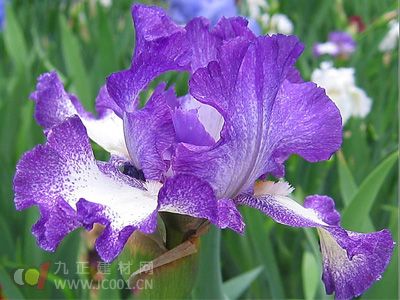Persian Iris Planting Technology:
1. Planting Location
Persian iris can be grown in a variety of environments, including glass or plastic greenhouses, as well as open fields. For outdoor planting, temporary coverings or mobile greenhouses are effective options, especially during spring and autumn. When choosing a location, it's essential to consider the appropriate growth stage, climate conditions, and greenhouse type.

For example, if the temperature is below 5°C during the growing period, planting indoors in a greenhouse is necessary to protect the bulbs from freezing. This helps prevent damage and ensures proper growth. In other seasons, when temperatures stay below 25°C, greenhouse planting is also suitable. If the air temperature is above 5°C and the soil temperature doesn't exceed 20°C, you can plant outdoors. Greenhouses provide better control over temperature and humidity, which can improve overall crop quality. In temperate regions, flowers grown in summer often have better quality than those in poorly ventilated greenhouses.
2. Soil Preparation
Well-drained, moist, and non-compacted soil is ideal for Persian iris production. A good soil structure is crucial, especially during the growing season. In heavy clay soils, it's recommended to mix in peat, vermiculite, or coarse sand up to 25 cm deep to improve drainage and aeration.
After planting, you can cover the soil with materials like rice husks, straw, pine needles, or black peat to prevent compaction. This also helps retain moisture, reducing the need for frequent watering.
3. Drainage System
Adequate drainage is vital to remove excess water and maintain healthy root development. A proper drainage system also allows for washing the soil with water, which helps reduce salt buildup caused by insufficient irrigation or certain planting stages.
4. Salt Sensitivity
Persian iris is highly sensitive to salt. Excessive salts in the soil can slow root growth and even cause damage, leading to dehydration in the flowers. Before planting, it’s important to thoroughly rinse the soil with 200–400 mm of water per square meter to reduce salt concentration.
In areas where crops like chrysanthemums, roses, or tomatoes are commonly grown, soil salinity may be high due to frequent fertilization. Similarly, late-harvest crops such as cypress can increase salt levels. To avoid this, synthetic fertilizers should not be used heavily before or after planting. A soil test should be conducted at least six weeks prior to planting to check salt levels.
The following salt levels must not exceed the recommended thresholds:
- Total salinity (electrical conductivity): 1.0–1.5 mmol/L at 25°C
- Chloride salt: 1.5–2.0 meq/L
- Potassium salt: 0.8–1.5 meq/L
- Nitrogen salt: 1.0–2.0 meq/L
- Magnesium salt: 2.0 meq/L
- Phosphorus salt: no more than 5.0 mg/L
The electrical conductivity of irrigation water should not exceed 0.5 mS/cm. In greenhouses, chloride levels should not go beyond 50 mg/L, while in open fields, they should not exceed 450 mg/L. If these standards are not met, planting is not advisable. However, if the water is slightly above standard, keep the soil as moist as possible to prevent salt accumulation due to drying.
5. Fertilization
It’s generally not recommended to apply base fertilizer before planting, as it can increase soil salt concentration and delay root growth. Instead, conduct a soil test before planting to ensure the soil has the right nutrient balance. After soil treatment and leaching, any deficiencies can be addressed directly through targeted fertilization.
Persian iris is sensitive to fluoride, so fluorine-containing fertilizers, such as phosphorus-based ones, should be avoided. Use bisphosphonate fertilizer instead.
6. Weed Control
The growth cycle of Persian iris is relatively short—only 8 to 12 weeks. During this time, mechanical methods like steaming, flooding, or plowing can help manage weeds without interfering with plant growth. Once planted, chemical herbicides are typically used, but care must be taken to avoid damaging the plants.
If weeds appear after planting, herbicide application should only occur once the bulbs are buried deep enough. The young shoots are safe from herbicides if they are at least 2 cm below the soil surface.
Before planting, you can spray a suitable herbicide in greenhouses or open fields to control weeds. If common herbicides don’t work against certain annual weeds, use a compound herbicide. Apply it on cloudy days, then rinse the plants the next morning. Be cautious about herbicide residues and follow these guidelines:
- Apply herbicides no more than twice per year per plot
- Use them only when necessary
- Avoid planting varieties that are sensitive to herbicides
Axial / Mixed Flow SubmersiblePump
Axial Flow Submersible pump,Vertical Axial Mixed Flow Submersible Pump,High Flow Submersible Pump,Submersible Axial Flow Pump,,Mixed Flow Submersible Pump
Zhengzhou Shenlong Pump Industry CO.,Ltd , https://www.waterpump-manufacturer.com